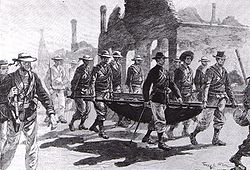| Seymour Expedition | |||||||
|---|---|---|---|---|---|---|---|
| Part of Boxer Rebellion | |||||||
 Admiral Seymour returning to Tianjin with his wounded men | |||||||
| |||||||
| Belligerents | |||||||
|
|
| ||||||
| Commanders and leaders | |||||||
|
|
| ||||||
| Strength | |||||||
|
2,157 total |
Tenacious Army 3,000 Muslim Kansu Braves 2,000 Boxers | ||||||
| Casualties and losses | |||||||
|
62 dead 232 wounded[2] | Unknown | ||||||
The Seymour Expedition (Chinese: 西摩爾遠征) was an attempt by a multinational military force to march to Beijing and relieve the Siege of the Legations and foreign nationals from attacks by Qing China's government troops and the Boxers in 1900. The Chinese army and Boxer fighters defeated the Seymour armies and forced them to return to Tianjin (Tientsin). It was followed later in the summer by the successful Gaselee Expedition.
- ^ Paul A. Cohen (1997). History in three keys: the boxers as event, experience, and myth. Columbia University Press. p. 49. ISBN 0-231-10651-3. Retrieved 28 June 2010.
- ^ Fleming, p. 89